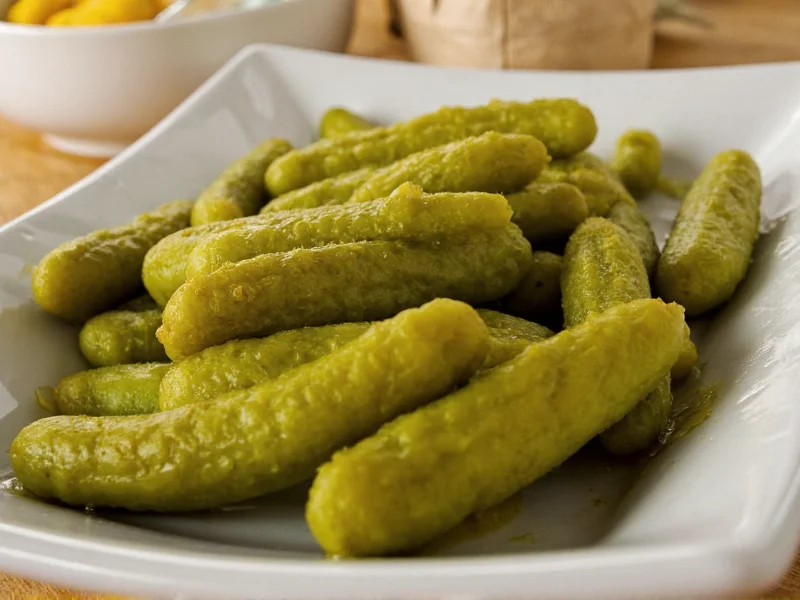When you ask are pickles considered fermented, the answer requires understanding two distinct preservation methods. While the term "pickle" broadly refers to any vegetable preserved in a solution, only those made through natural fermentation qualify as fermented foods. This distinction matters for flavor, texture, and potential health benefits.
The Fundamental Difference: Fermentation vs. Vinegar Pickling
Many people don't realize there are two completely different processes for making pickles:
| Characteristic | Fermented Pickles | Vinegar-Based Pickles |
|---|---|---|
| Preservation Method | Natural lacto-fermentation | Vinegar brine (acetic acid) |
| Time Required | Days to weeks | Hours to days |
| Probiotics | Contains live beneficial bacteria | No live probiotics (pasteurized) |
| Taste Profile | Complex, tangy, develops over time | Consistent sharp vinegar taste |
| Shelf Stability | Refrigeration required after opening | Room temperature storage (unopened) |
Understanding Lacto-Fermentation in Pickle Making
True fermented pickles undergo a process called lacto-fermentation, despite the name containing "lacto" (which might suggest dairy involvement). This natural preservation method relies on Lactobacillus bacteria present on cucumber skins and in the environment.
During traditional fermentation:
- Cucumbers are submerged in a saltwater brine (typically 2-5% salt solution)
- Natural bacteria convert vegetable sugars into lactic acid
- The increasing acidity preserves the cucumbers while developing complex flavors
- Beneficial probiotic bacteria proliferate in the process
This ancient preservation technique predates vinegar pickling by centuries. Historically, all pickles were fermented—there was no alternative method for long-term vegetable preservation.
Why Most Store-Bought Pickles Aren't Actually Fermented
The pickles lining supermarket shelves typically use a vinegar-based method developed during the industrial revolution. This quick-process method:
- Uses vinegar (acetic acid) instead of natural fermentation
- Requires heat processing (pasteurization)
- Completes in hours rather than days or weeks
- Creates consistent flavor and appearance for mass production
When examining are store bought pickles fermented, the answer is generally no. Most commercial brands like Vlasic, Claussen (unrefrigerated varieties), and Heinz use vinegar preservation. You'll typically find them in the regular grocery aisle rather than the refrigerated section.
How to Identify Truly Fermented Pickles
If you're searching for how to tell if pickles are fermented, look for these indicators:
- Refrigeration requirement - Authentic fermented pickles must be refrigerated
- Ingredients list - Should contain only cucumbers, water, salt, and spices (no vinegar)
- "Live cultures" or "probiotics" mentioned on packaging
- Slightly cloudy brine (a sign of active fermentation)
- Sold in refrigerated section of health food stores or specialty markets
Brands like Bubbies, Wildbrine, and many local artisan producers offer genuinely fermented options. You might also find them at farmers' markets where small-batch producers sell refrigerated fermented vegetables.
Why the Fermentation Distinction Matters
Understanding are kosher dill pickles fermented (most aren't) reveals why the method affects more than just preservation:
Flavor Complexity
Fermented pickles develop nuanced flavors that evolve over time, while vinegar pickles maintain a consistent but one-dimensional sourness. The fermentation process creates hundreds of flavor compounds compared to the straightforward acidity of vinegar.
Probiotic Benefits
Authentic fermented pickles contain live cultures that may support gut health—a benefit completely absent in vinegar-pickled varieties. This explains growing interest in health benefits of fermented pickles among nutrition-conscious consumers.
Digestibility
Some people find traditionally fermented pickles easier to digest than vinegar-pickled versions, possibly due to the enzymatic activity during fermentation breaking down certain compounds.
Making Your Own Fermented Pickles
If you're exploring traditional fermented pickle recipe options, the process is remarkably simple:
- Select fresh, unwaxed cucumbers (Kirby varieties work best)
- Prepare a 3-5% saltwater brine (30-50g salt per liter of water)
- Add spices like dill, garlic, mustard seeds, and grape leaves (for crispness)
- Submerge cucumbers completely in brine
- Cover loosely and store at room temperature (68-75°F/20-24°C)
- Wait 5-14 days depending on temperature and desired sourness
- Refrigerate to slow fermentation when desired flavor is achieved
This method requires no special equipment beyond jars and weights to keep cucumbers submerged. The fermentation process naturally preserves the pickles while developing complex flavors and beneficial bacteria.
Navigating Pickle Labels for Fermentation Clarity
Food labeling can be confusing when determining where to buy fermented pickles. Watch for these terms:
- "Naturally fermented" - Indicates true lacto-fermentation
- "Refrigerate after opening" - Suggests possible fermentation (though not definitive)
- "Contains live cultures" - Confirms fermentation
- "Vinegar" in ingredients - Means it's not fermented (unless listed as optional)
- "Heat treated" or "pasteurized" - Kills any potential probiotics
Be cautious of terms like "fermented flavor" or "fermentation style" which often indicate vinegar-based products attempting to mimic fermented taste without the actual process.











 浙公网安备
33010002000092号
浙公网安备
33010002000092号 浙B2-20120091-4
浙B2-20120091-4